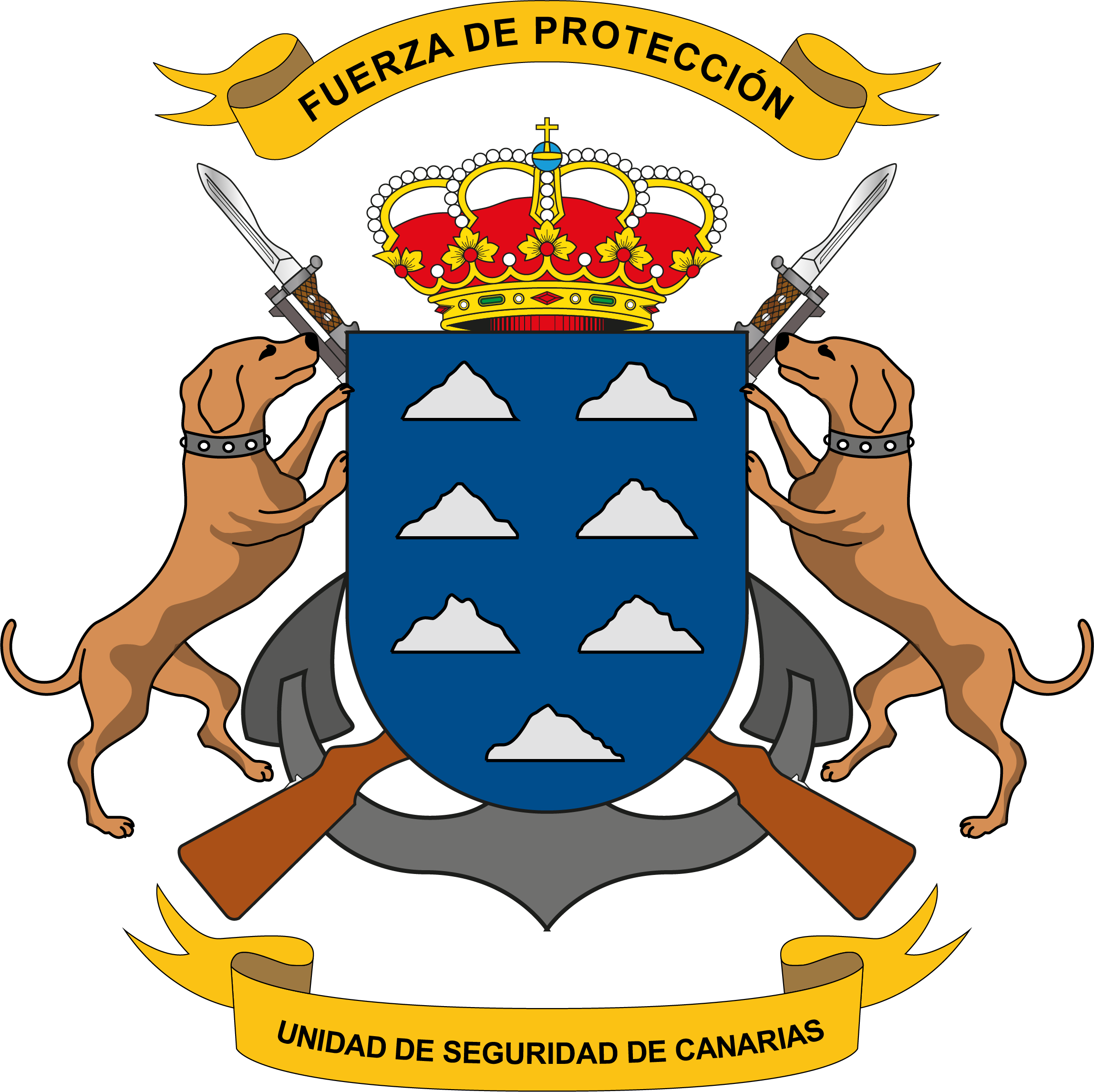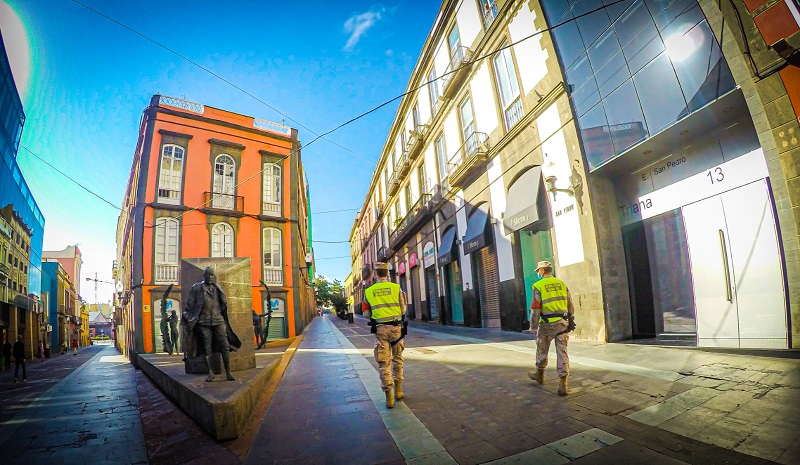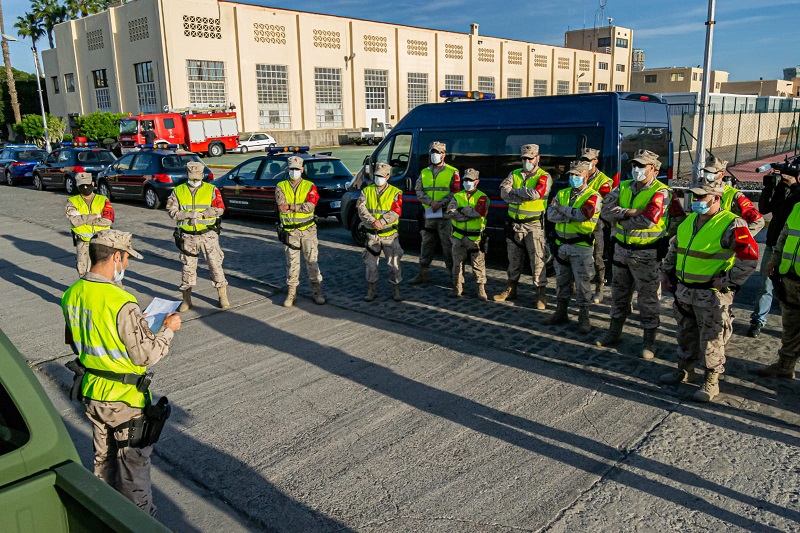Canary Islands Security Unit (USCAN)
Marine Corps
The Canary Islands Security Unit (USCAN) welcomes you to its website. The USCAN is part of the Marine Corps Protection Force and its mission is therefore to provide security and protection to Spanish Navy personnel and facilities in the Canary Islands.
Although this group is the "youngest" Unit of the "oldest" Marine Corps of the world, we nevertheless nourish the values and tradition of this glorious Institution. Given the importance of its geographical situation, the USCAN is a key element of the Spanish Navy contribution to the Defense of Spanish interest.
As of 2002, this Unit is located at the Las Palmas Arsenal in Gran Canaria, near the Alcaravaneras beach.
The current USCAN workforce consists of 202 men and women: 1 Lieutenant-Colonel, 10 officers, 25 NCOs and 166 soldiers. They are all Marines except for a Quartermaster Corps Lieutenant and an Administration Chief Petty Officer.
USCAN Organisation:
- Staff
- Security Company
- Security platoon
- Special Operational platoon (EOS)
- Craft Unit
- Naval Police Company
- Police platoon
- Escort platoon
- Dog Unit
- Staff and Service Company
- Transport
- Communications
- Service platoon
- The Staff assists the Unit Commander in decision making tasks.
- The Security Company provides the necessary security personnel to the facilities concerned. It also has specific trained personnel for MIO operations (Maritime Interdiction Operations).
- The Naval Police Company provides escort services to naval authorities and security deployments for military ceremonies and celebrations. It is also in charge of the transport of ammunition and detainees.
- The Staff and Service Company provides the necessary elements for the logistic support of the Group (communications, transport, etc).
As we said above, the Canary Islands Security Unit is part of the Marine Corps Protection Force whose mission is to provide security and protection to Spanish Navy personnel, centers and facilities in the areas in and around the Canary Islands.
Our daily activity is centered on training our men and women for MC action. Other responsibilities (escort duties, naval police) are also taken into account, as well as physical training, firing drills and boarding exercises in order to be ready for MIO operations from Spanish Navy ships.
Weapons: Like the rest of Marine Corps units, the USCAN has a wide assortment of pistols, HK G-36 rifles, MG42 machineguns, MAUSER rifles, ACCURACY rifles, HK G-36 KV rifles, and MINIMI and BROWNING machineguns.
Vehicles: The USCAN has a series of light and heavy vehicles like Land Rover DEFENDER; Nissan TERRANO and PATHFINDER; IVECO-PEGASO Lorries, vans, minivans and police cars.
The unit is equipped with holographic and infrared sights (AN/PEQ-2A), night vision goggles (AN/PVS-14 and AN/PVS-7D), telescopic sights (SIMRAD KN202G), telemeters and telescopes.
At the very beginning of our deployment in the Canary Islands, we were tasked with the protection of merchant ships in port. From 1956 to 1976, the MC Unit participated in several operations on the occasion of the Independence of different West African nations.
The Canary Islands Unit also took part in several shows of strength in the south of Morocco and Western Sahara as part of a landing force on board the corvettes "Atrevida" and "Descubierta".
The last Spanish flag in Western Sahara was lowered by Marine Corps forces on January 9th 1976 in accordance with the decolonization plans of the Madrid Agreements.
In 2008, the USCAN took part in the peace-keeping operation LIBRE HIDALGO in the Lebanon. Next year it participated in operation ALTHEA in Bosnia-Herzegovina integrated into the 7th MC Expeditionary Platoon.
In 2010 a Special Operational Team deployed in the Indian Ocean for operation ATALANTA on board the frigate "Victoria".
As regards multinational training exercises, the USCAN has participated twice in exercise PARTNERSHIP STATION in African waters (2010-2011) on board the Spanish Navy's OPV "Centinela".
The USCAN carries out three or four training exercises every year in different islands of the archipelago, usually in collaboration with other Services like the Air Force SAR helicopters, or the 6th Army helicopter battalion. Firing drills are conducted in Army ranges.
The USCAN has built upon excellent relations with the civilian Authorities of the Islands, which undoubtedly contribute to foster and enhance the image of the Spanish Navy and Armed Forces in our society.
Marine Captain Arriaga y Guzmán was the first Commanding Officer of the Canary Islands detachment (1942). The first Marines were billeted in pontoon ships in Puerto de la Luz, but soon moved to a building near Las Canteras beach shared with Hydro graphic Institute.
In 1970 new barracks were built in the northern part of the city: The Manuel Lois Headquarters. Its Flag was presented in December 1974 by the Town Council of San Bartolomé de Tirajana.
In the year 2000, as part of a Navy rearrangement, the size of the Unit was downgraded and two years later the Headquarters moved to Las Palmas Arsenal.




 + 11
+ 11











